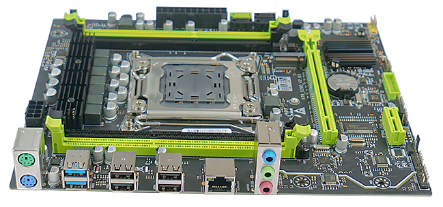What are the components of the motherboard?
1. Chipset
The chipset is one of the core components of the motherboard. It consists of a northbridge chip and a southbridge chip (in some modern motherboards, it has been integrated into one chip). The northbridge chip is mainly responsible for high-speed communication with the CPU and control of high-speed components such as memory and graphics cards. It determines the type and frequency of memory that the motherboard can support, as well as the type of interface with the graphics card (such as the version of PCI-E). The southbridge chip is mainly responsible for managing low-speed I/O devices, such as USB interfaces, hard disk interfaces, network card interfaces, etc. It coordinates the communication between the computer and external devices to ensure that data can flow in an orderly manner between different devices.
2. CPU slot
The design of the CPU slot varies depending on the CPU. The two common types are LGA and PGA. The LGA slot is connected to the CPU through metal contacts, while the PGA slot uses pins. Different CPU slots ensure that only the matching CPU can be correctly installed on the motherboard, which also reflects the close compatibility requirements between the motherboard and the CPU.
3. Memory slots
Memory slots are usually of different types such as DDR, DDR2, DDR3, DDR4, etc., corresponding to different generations of memory technology. The number and arrangement of these slots determine the maximum memory capacity that the motherboard can support. For example, some motherboards may have four DDR4 memory slots, which can theoretically support up to 128GB of memory capacity (assuming that the maximum capacity of a single memory stick is 32GB).
4. Expansion slots
The expansion slot is an interface provided by the motherboard for users to install expansion cards. Common expansion slots include PCI slots, AGP slots (basically eliminated) and PCI-E slots. PCI slots can be used to install various low-speed to medium-speed expansion cards such as sound cards, network cards, and TV cards. PCI-E slots are currently the mainstream high-speed expansion slots. They are not only used to install graphics cards, but also to install high-speed solid-state drive controllers, 10G network cards and other high-speed devices.
5. BIOS chip
The BIOS chip is a very important component on the motherboard. It stores the basic input and output system, which is a set of programs fixed in the chip. When the computer starts, it will run first to initialize the various components on the motherboard, including detecting whether the CPU, memory, hard disk and other devices exist and work properly. At the same time, the BIOS chip is also responsible for the system's boot process, which determines whether the computer starts from the hard disk, optical drive or other bootable devices.
6. Clock generator
The clock generator provides clock signals for the entire computer system. These clock signals are used to synchronize the operation of various parts of the computer to ensure that data can be transmitted and processed at the right time. Without the clock signal provided by the clock generator, the computer system will not work properly.
7. I/O chip
The I/O chip is mainly responsible for managing some input and output devices, such as keyboards, mice, printers, etc. It connects to these devices through specific interfaces, processes the signals from the devices, and then transmits them to other components on the motherboard. For example, when a user presses a key on the keyboard, the I/O chip receives the signal and converts it into a format that the computer can recognize, and then passes it to the CPU for processing.
8. Power interface
The power interface is the part where the motherboard connects to the power supply. Common power interfaces include the 24-pin main power interface and the 8-pin CPU auxiliary power interface (depending on the motherboard, there may be other forms of power interfaces). These power interfaces provide power support for the entire motherboard and the various components installed on the motherboard to ensure that they can work properly.
9. Various interfaces
The motherboard also has a variety of interfaces for connecting different external devices. These include SATA interfaces for connecting hard drives and optical drives; USB interfaces for connecting USB devices such as USB flash drives, mice, keyboards, etc.; PS/2 interfaces for connecting keyboards and mice (although PS/2 interfaces have been gradually eliminated in modern computers); HDMI interfaces for connecting high-definition monitors; VGA interfaces for connecting ordinary monitors, etc.
Today, we show you a motherboard of Angxun X79 Chipset Series , which is Angthumb X79-S290-V2.84,the following parameters are supported:
▲Support for the Intel Xeon E5 LGA2011-0 processor
▲Support four-channel DDR 3 memory, support the maximum capacity of 128GB
▲Supports the 1 xM. 2 slot
▲Support 3x SATA 2.0,1x SATA 3.0 socket
▲The rear IO provides 4 x USB2.0 and 2 x USB3.0 Interfaces Built-in pin extension of 4 x USB2.0,2 x USB3.0 interface
▲Support for 5.1 sound channel ALC897 chip
▲Support for the 1 xPS 2 keyboard and mouse
▲Support 1 x Gigabit network card, support PXE and network wake-up function
▲Support for a 1 x PCIE X16 slot, and a 1 x PCIE X1 slot
Angxun has been in the motherboard industry for more than 20 years. Registered the brand Angthumb in many countries,we have focused on the production and research and development of intel motherboard,all in one motherboard,and Industrial motherboard,server motherboard ,RAM,SSD,CPU,GPU etc.The website is : www.angthumb.com to know more!


Contact: Tom
Phone: +86 18933248858
E-mail: tom@angxunmb.com
Whatsapp:+86 18933248858
Add: Floor 301 401 501, Building 3, Huaguan Industrial Park,No. 63, Zhangqi Road, Guixiang Community, Guanlan Street,Shenzhen,Guangdong,China
We chat
